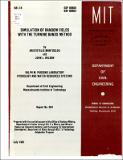Simulation of Random Fields with the Turning Bands Method
Author(s)
Mantoglou, Aristotelis; Wilson, John L.
Download08235082.pdf (7.295Mb)
Metadata
Show full item recordAbstract
This report presents and extends the Turning Bands Method (TBM) for the synthetic simulation of random fields. Originally introduced by G. Matheron (1973) of the Ecole des Mines de Paris, the TBM can be applied to stationary or non-stationary fields. For two and three dimensional stationary isotropic fields the general TBM equations are derived with particular emphasis on the two dimensional case. In a new approach the unidimensional line process is generated by a simple spectral method, a technique which can be generally applied for any two dimensional covariance function and is easily extended to anisotropic processes. In a second approach the line process is generated as a moving average process for which corresponding one dimensional equivalents are derived for special two dimensional covariance functions. The convergence properties of the TBM with the number of lines is described mathematically and by example, and guidelines are presented for the selection of model parameters. The TBM is compared to other methods in terms of cost and accuracy, demonstrating that the TBM is as accurate and far less expensive than any other existing technique. Using the unidimensional spectral method the TBM is extended to the direct generation of stationary anisotropic processes. Examples of this generation are given with a comparison between theoretical and sample statistics. Equations are derived giving the covariance function and the spectral density function for the process of areal averages of stationary processes. It is observed that reduced covariance between areas can damp out quickly, relative to the size of the areas, suggesting the possibility of approximating areal average covariance by point covariance in some instances. The areal average process is, in general, anisotropic. Thus the anisotropic TBM is applied for direct generation of the areal average process. The comparison of the theoretical and sample statistics is excellent. The Turning bands method for the simulation of nonstationary random fields (IRF) is presented, using a Wiener-Levy process for line generation as suggested by Matheron (1973). Examples are given for IRF's of zero, first and second order.
Description
Prepared with the partial support of the Office of Surface Mining, Department of Interior through M.I.T.'s Mining and Mineral Resources Research Institute, and the Agency for International Development, Department of State, through M.I.T.'s Technology Adaptation Program.
Date issued
1981-07Publisher
Cambridge, Mass. : Ralph M. Parsons Laboratory Hydrology and Water Resources Systems, Dept. of Civil Engineering, Massachusetts Institute of Technology
Other identifiers
264
Series/Report no.
R (Massachusetts Institute of Technology. Department of Civil Engineering) ; 81-16.Report (Ralph M. Parsons Laboratory for Water Resources and Hydrodynamics) ; 264.